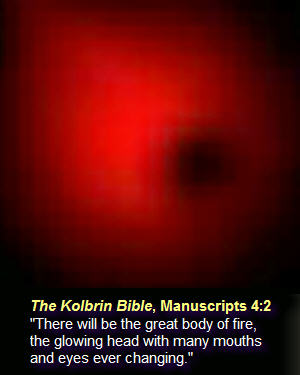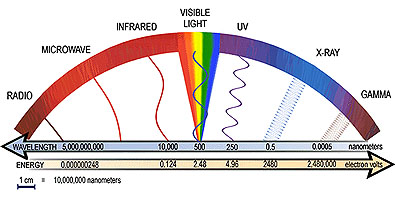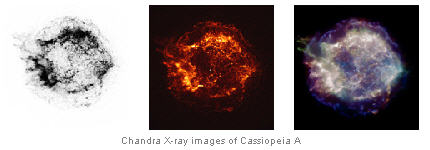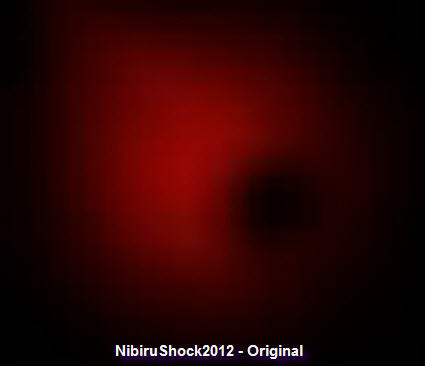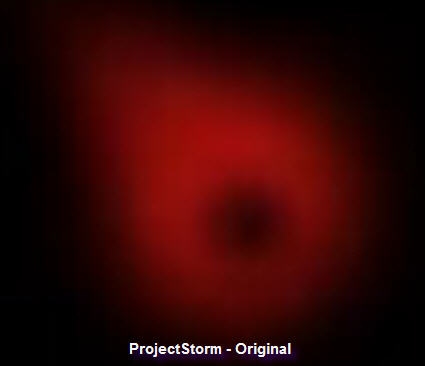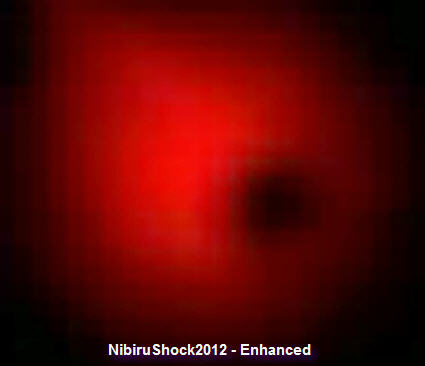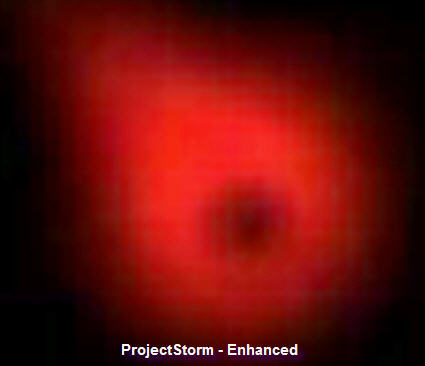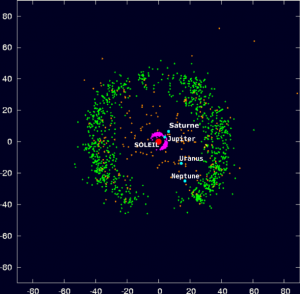Des images de la "Planète X" auraient été prises par le SPT
Information ou désinformation ? "L'énormité" des faits avancés par cet article les rend invraisemblables. Et si les auteurs de cet article apparaissent relativement sérieux dans leur démarche de recherche, il subsiste malgré tout pas mal de zones d'ombres. D'autant plus que le contexte de publication de cet article sur yowusa.com nous donne l'impression d'assister à une opération marketing pour la vente de bouquins (!)... Nous sommes néanmoins en droit de nous interroger: la "post-analyse" de cet article est fournie dans un document à part. Merci à Charles d'avoir transmis ces informations.
Sommaire
- 1 Premières images de la Planète X / Nibiru diffusées par un informateur anonyme du "South Pole Telescope" (SPT)
- 2 1. Introduction et premières découvertes
- 2.1 Information erronée ("Hoax") déclarée le 10 mars 2008 et retirée le 12 mars 2008
- 2.2 Mise à jour de l'article #1 — 03-Mars-2008
- 2.3 Vidéo de réponse #1 — 05-Mars-2008
- 2.4 Images en fausses couleurs
- 2.5 The South Pole Telescope (SPT)
- 2.6 Les équipes mystérieuses du SPT
- 2.7 Les tentatives d'étouffement de l'affaire (Intelligence Cover-up)
- 2.8 Une chaine d'information internationale
- 2.9 Les images de NibiruShock2012
- 2.10 Initial Findings
- 3 2. Revendication du hoax et réfutations
- 4 3. Renseignement humain
- 5 4. Orbite des satellites
- 6 5. Groupe d'objets
Premières images de la Planète X / Nibiru diffusées par un informateur anonyme du "South Pole Telescope" (SPT)
Marshall Masters - yowusa.com - 02-Mars-2008 - mise à jour: 05-Mars-2008
1. Introduction et premières découvertes
http://yowusa.com/planetx/2008/planetx-2008-03a/1.shtml
Information erronée ("Hoax") déclarée le 10 mars 2008 et retirée le 12 mars 2008
La première vidéo de NibiruShock2012 était très convaincante et nous avons publié une analyse détaillée de celle-ci sur le site Web yowusa. Cette vidéo était soit authentique (nous avons montré qu'elle ne pouvait être faite avec Photoshop) [NdT: référence ??] soit un canular sophistiqué.
Puis NibiruShock2012 a récemment posté une deuxième vidéo en réponse à notre article et nous avons nous-mêmes répondu avec une vidéo YouTube. Nous avions un objectif en tête: voir si, à l'instar des joueurs de poker, NibiruShock2012 tenterait d'augmenter sa mise.
NibiruShock2012 a ensuite diffusé une troisième vidéo intitulée "(20) (8) (9) (19) (9) (19) (1) (8) (15) (1) (24)" en réponse à notre vidéo, avec la message suivant:
THIS--- (20) (8) (9) (19)
IS ---------( 9) (19)
A ----------- ( 1)
HOAX --- ( 8) (15) (1) (24)
Il est important de remarquer que, quelle que soit la personne qui a diffusé ce troisième message sous le pseudonyme NibiruShock2012, elle est restée comme précédemment, anonyme. Par conséquent, jusqu'à ce que la ou les personnes qui ont diffusé ces vidéos se manifestent ouvertement, il reste impossible de dire qui est l'auteur de ce troisième message.
Ceux qui prétendent que la planète X / Nibiru n'existe pas insistent toujours sur l'existence de preuves irréfutables. "Montrez-moi des images", martèlent-ils avec raison. Nous aussi, nous avons vu de nombreuses photos et de vidéos de la planète X qui au fil des ans ne s'avéraient être que des canulars.
Toutefois, nous ne cautionnons non plus pas le ton caustique et la sentence auto-contenue de l'abrasif "montrez-moi les images" des incrédules ("debunkers"), car pleine de préjugés.
Cependant, comme le dit ce vieil adage chinois, "Faites attention à ce que vous souhaitez, ces souhaits pourraient prendre vie". En effet, nous disposons maintenant de ce que nous considérons être la première preuve crédible d'images de la planète X / Nibiru, par une chaîne d'information qui conduit jusqu'au au "South Pôle Telescope" (SPT) situé en Antarctique.
Le 20 février 2008, un réalisateur sur Youtube postant depuis la suisse et portant le pseudonyme NibiruShock2012 a diffusé des images de la planète X qui auraient été prises par le "South Pole Telescope" (SPT). Intitulé "Nibiru / Planet X, photos prises en Janvier 2008", cette vidéo a été consultée plus de 39000 fois depuis sa date de sa publication.
Mise à jour de l'article #1 — 03-Mars-2008
Une deuxième vidéo a été diffusée par NibiruShock2012 le jour qui a suivi notre première publication de cet article et elle est jointe ici pour information
Notez que l'analyse effectuée dans cet article ne concerne que la première vidéo, celle publiée le 20 février 2008.
Vidéo de réponse #1 — 05-Mars-2008
C'est notre réponse vidéo sur YouTube en retour de la première des deux vidéos de NibiruShock2012.
Nous avons posé plusieurs questions à NibiruShock2012 et pour lesquelles nous étions en attente de réponses.
Images en fausses couleurs
Une réaction généralement rencontrée face aux images de NibiruShock2012 est qu'il est impossible de les obtenir avec un télescope fonctionnant en ondes submillimétriques, à l'instar du South Pole Telescope (SPT). Cependant, il est habituel de rendre en fausses couleurs des images prises par de tels télescopes.
Images de Chandra en fausses couleurs
Les images prises par les télescopes qui observent dans des longueurs d'ondes "invisibles" créent souvent ce que l'on appelle des "images en fausses couleurs". Ceci car les couleurs utilisées pour le rendu ne sont pas "réelles" mais choisies afin de mettre en évidence certains aspects importants. Le choix de la couleur est généralement une affaire de goût et s'applique comme un code dans lequel les couleurs peuvent être associées à l'intensité ou à la luminosité des radiations issues de différentes régions de l'image, ou bien encore, en relation avec l'énergie dégagée par l'émission.
Par exemple, l'image sur la gauche en noir et blanc, prise par le télescope Chandra en rayons X présente les restes de la supernova Cassiopea A. Les parties sombres qui sont les émissions en rayons X les plus intenses, à l'inverse, les parties les plus claires représentent les zones d'émission les moins intenses, et les zones blanches sont associées à pratiquement aucune émission. Dans la version jaune et orange du milieu, un "code couleur" différent a été utilisé. Ici, le blanc et les couleurs jaunes représentent les zones de plus forte intensité, l'orange et le rouge les zones de moyenne intensité, et le noir représente peu ou pas d'émission.
Il est important de noter qu'en l'absence de confirmation indépendante, nous ne pouvons authentifier ces "images en fausses couleur". Cependant, un certain nombre d'aspects de cette histoire nous incite à penser que cette vidéo "inofficielle" est crédible, ils reposent sur les éléments suivants:
- Les équipes mystérieuses du SPT
- Les tentatives d'étouffement de l'affaire
- La chaîne d'information internationale
- Les images de NibiruShock2012
Suite à une rapide description du South Pole Telescope, cette introduction discutera brièvement de ces différents aspects.
The South Pole Telescope (SPT)
En avril 2006, yowusa.com a été le premier a dévoiler l'histoire du SPT dans le contexte de la recherche de la planète X / Nibiru
Yowusa.com, 26-Avril-2006
South Pole Telescope (SPT) — Le nouveau détecteur américain de la planète X
Maintenant nous avons la confirmation dont nous avions manqué pendant des années, le South Pole Telescope (SPT). Bien plus performant et durable que la sonde IRAS (1983) ainsi que le télescope spatial, cet observatoire sur mesure sera bientôt capable de suivre la Planète X / Nibiru depuis le ciel vierge d'Antartique.
Pourquoi les Etats-Unis dépensent-ils des fortunes dans le transport de cet instrument massif avec d'énormes C-130 vers la plus désolée, inhospitalière et inaccessible région du monde ? Parce que c'est à cet endroit que les astronomes prendront leur meilleurs photos souvenirs et c'est une bonne nouvelle. Le résultat de leurs observations multi-spectrales se transformeront en données permettant de sauver des vies.
Dans cet article, nous expliquons pourquoi le SPT est l'instrument parfait, situé à l'emplacement parfait et à un moment parfait pour observer la Planète X / Nibiru, assumant une hypothèse d'une approche par le sud du coeur de notre système solaire.
Depuis nous avons continuellement surveillé Internet à la recherche de nouvelles fraîches, d'articles, de vidéos, etc., ayant trait à cette annonce remontant à avril 2006. La première information fut une vidéo YouTube intitulée South Pole Telescope Commute qui a été postée en décembre 2007 par les chercheurs du SPT.
Ce que nous trouvons intéressant au travers de cette vidéo c'est la grande précaution prise par les chercheurs pour éviter de montrer quoique ce soit ayant trait au télescope massif, qui est ostensiblement financé par le gouvernement américain pour la recherche civile.
Après tout, les "geeks" adorent montrer aux gens leurs derniers jouets high-tech et cette vidéo fait tout sauf cela. Ceci a d'autant plus piqué notre curiosité en raison d'un rapport réalisé par une source fiable, située en Nouvelle-Zélande, à peine quelques semaines plus tôt.
Les équipes mystérieuses du SPT
A la mi-décembre 2007, un aficionado de longue date de yowusa.com, Christopher Ferri, fondateur et CEO de a-s-s-e-t.com, un système bancaire de paiement en ligne pour les marchands de Nouvelle Zélande, a pris contact avec nous avec de très intéressantes informations.
Selon Christopher, plusieurs de ses membres marchands en Nouvelle Zélande discutaient d'une nouvelle tendance assez curieuse ayant cours à la base d'Amunsen-Scott, la station d'Antarctique où est située le SPT.
En temps ordinaire, les vols de C-130 vers la station font une escale en Nouvelle Zélande pour faire le plein et charger des provisions supplémentaires fournies par les marchands locaux, mais aussi fournir le transport pour les scientifiques voyageant jusqu'à la station.
Cependant, en décembre 2007, une tendance troublante a émergé. Des équipes secrètes de chercheurs ont commencé à arriver à la station par des vols sans escale depuis les US. Bien que la distance soit considérable, c'est une chose possible considérant que ces C-130 sont des transports militaires disposant de capacités de ravitaillement en vol.
Christopher reporta que ses marchands Néo-Zélandais avaient entendu des histoires de chercheurs non américains, qui disaient que ces mystérieuses équipes du SPT arrivaient à l'improviste sur des vols sans escale pour travailler durant de brèves périodes au SPT. Durant leurs passages, ces équipes mystérieuses du SPT restaient isolées des autres, et ensuite repartaient comme elles étaient venues.
Compte tenu du fait que la station d'Amundsen-Scott au Pôle sud, est une grande base civile de recherche international, les allées et venues mystérieuses de ces équipes spéciales venues des Etats Unis ont visiblement troublé les chercheurs civils des autres pays.
Ceci nous a incité à accentuer notre vigilance et rester à l'affut de toute nouvelle touchant au SPT. C'est pour cette raison que nous avons été pu relever les photos postées par NibiruShock2012 sur Nibiru / la Planète X, prises en janvier 2008 seulement quelques heures après que la vidéo ait été publiée sur YouTube. A ce moment là, elle n'avait été visualisée que 346 fois, alors qu'à la date de consultation de cet article elle a été visualisée 39 000 fois.
En première analyse, le test plus simple détectant un hoax sous photoshop a été passé [NdT: Quel test ? Comment ?], mais ces photos sont-elles authentiques pour autant? Nous nous sommes immédiatement posés les questions suivantes:
- Où est situé cet objet dans le ciel ?
- Est-ce qu'il s'approche de nous? A quelle distance se situe t-il ?
- Dans l'affirmative, est-ce qu'il va accélérer d'où il est maintenant jusqu'à ce qu'il passe au point le plus proche du soleil ?
En l'absence d'une seconde source de vérification, l'approche logique était de valider ces informations directement avec la source. Dans ce contexte, cela commençait par NibiruShock2012, le producteur de la vidéo postée sur YouTube. C'est là que nous avons constaté qu'il y avait clairement une tentative de camouflage.
Les tentatives d'étouffement de l'affaire (Intelligence Cover-up)
Ici, l'auteur a besoin de passer momentanément à la première personne
Après avoir trouvé la vidéo de NibiruShock2012 sur YouTube, j'ai essayé de contacter l'auteur au travers du système de messagerie de YouTube. Cependant, mes multiples tentatives de prise de contact ont été bloquées, aussi j'ai effectué quelques tests.
S'il vous plaît prenez note que même si je ne suis pas disposé à révéler ma méthode de test [NdT: un autre test dont l'on ne saura rien!], j'aimerais vous dire qu'avant de démarrer ma propre société d'édition, j'ai travaillé dans l'industrie informatique pendant vingt ans. Durant ces dernières 8 années, j'étais analyste technique freelance au sein de la Silicon Valley. J'étais spécialisé sur les technologies Internet touchant aux centres de données, et ma liste de clients incluait AT&T, HP, Lockheed Martin, Oracle et SUN Microsystems.
Mes tests montrèrent que mes messages ainsi que le canal de commentaire menant à NibiruShock2012 étaient écoutés et sélectivement bloqués depuis l'intérieur du centre de données de YouTube — mais pas par aucun des serveurs YouTube!
Comme ils disent à Washington, "C'est de la dissimulation, pas un crime", et ceci a levé un certain nombre d'alarmes, et pas seulement à notre niveau.
D'autres chercheurs connus de la Planète X observaient la même chose, et c'est pourquoi je me suis mis en contact avec l'auteur Benjamin Cropley auteur de la 5ème partie ici — Groupe d'objets. Lui, ainsi que nombreux autres chercheurs de la Planète X en Angleterre, ont expérimenté ce même blocage sélectif ainsi que l'espionnage des paquets de données.
Depuis lors, qui que ce soit bloquait nos efforts de contact a supprimé les blocages sur le système de messagerie et de commentaires de YouTube, et il y a maintenant plus de 400 commentaires sur la vidéo. Toutefois, cela ne représente rien de plus que quelqu'un qui ferme le portail après que le cheval se soit ébroué (?). Ce "quelqu'un" est, bien sûr, une agence américaine. Cette question nous dirige vers la source initiale de la fuite.
Une chaine d'information internationale
Dans la 3ème partie — Renseignement Humain (HUMINT), Janice Manning utilise l'ensemble du texte intégré et associé avec la vidéo YouTube de NibiruShock2012 correspondant aux photos prises en janvier 2008.
Selon son analyse, la vidéo fourni l'évidence de 3 "voix d'auteur" distinctes et séparées, à rattacher à :
- l'informateur du SPT,
- au réalisateur de la vidéo,
- l'utilisateur YouTube qui a posté la vidéo
NibiruShock2012, l'utilisateur YouTube âgé de 37 ans [NdT: comment l'âge est-il connu ?] vit en suisse (un pays neutre) et est la dernière personne de cette chaîne d'information. A contrario, l'informateur du SPT est plus certainement un employé du gouvernement américain ayant eu accès à ces images. C'est l'élément clé.
L'informateur du SPT a clairement choisi des images suffisamment représentatives pour ceux qui voudraient les examiner en détail.
Les images de NibiruShock2012
Les debunkers auto-désignés se sont concentrés sur le texte intitulé "A propos" [NdT rédigé sur la page du site YouTube depuis disparu] accompagnant l'envoi de NibiruShock2012 et l'ont utilisé pour attaquer la vidéo. (They use a sloppy, agenda-driven approach ?). Cela est détaillé dans l'analyse de Janice Manning. Son analyse nous révèle que NibiruShock2012 est, techniquement parlant, un analphabète. Il utilise des informations publiques pour introduire la vidéo. Les debunkers ont négligé de prendre en compte l'existence de ce matériel publique.
Par conséquent notre analyse est centrée sur la vidéo elle-même. Cela inclut les images de la vidéo postée par NibiruShock2012, le texte inclut dans cette vidéo sur les photos prises par le télescope et le texte CGI du réalisateur de la vidéo.
- Partie 2 — Revendication du hoax et réfutations, nous présentons une analyse détaillée publiée sur YouTube par ProjectStorm qui prouve, contrairement à ce qu'il prétend, que les images en NibiruShock2012 vidéo n'ont pas été créées avec Adobe Photoshop ou une application équivalente.
- 4. Orbite des satellites, Jacco van der Worp, MSc of the Netherlands uses a specially enhanced, inverse overlay to discuss the stable and unstable orbits of four satellites in orbit around the central object in this system.
- Partie 5 - Groupe d'objets, Benjamin Cropley, an amateur astronomer and Planet X researcher in the United Kingdom, uses additional enhanced images to build on Jacco's findings and discuss the relevance of the NibiruShock2012 images to Andy Lloyd's Dark Star Kuiper Gap hypothesis.
Based on the respective efforts of the various members of this international analysis group, our initial findings are of critical import to all those with an interest in Planet X / Nibiru.
Initial Findings
Based on our current findings, It appears to us that an American working on (or having access to) the SPT leaked the images to a foreign national, who then created the video and relayed it to a trusted third party Switzerland. It was then posted on YouTube.
1. Given the scope of effort involved in bringing this video to the public's attention, we've yet to see any proof of a hoax. However, we cannot authenticate the images, either.
2. Due to the YouTube sniffing and blocking experienced by Marshall Masters, Benjamin Cropley and other Planet X researchers in the UK, we believe this leak was over-managed by a security agency in a botched damage control effort. No doubt, the denials will be quick to come, but this singular aspect lends the single most convincing element of credibility to this informant leak story.
3. This is obviously a concerted effort by a group of individuals. This group could be a informal network of alarmed people. The botched cover-up leads us to conclude that this was not a disinformation trial balloon effort, as some maintain.
4. The intent of the informants is to create awareness. Their approach is noble and can in no way be viewed as a conspiratorial rant against any government.
5. We advise continued monitoring of this Swiss leak source.
As we are unable to contact the any of the informants and cannot independently confirm this report as verified, we can only publish these series of articles as preliminary conclusions. As compelling as they are, they nonetheless must be viewed as speculative at this time.
We will continue to follow this story and report additional findings as they come to light. We can only hope the informants of these "unofficial" images release more of them, as they have promised.
—Marshall Masters, Publisher Your Own World USA
2. Revendication du hoax et réfutations
http://yowusa.com/planetx/2008/planetx-2008-03a/2.shtml
Marshall Masters - YOWUSA.COM - 02-March-2008
PUBLIC NOTICE: We are unable to contact any of the informants and cannot cannot independently confirm this report. As compelling as these images are, any conclusions drawn from them must be viewed as speculative at this time.
On February 20, 2008, a 37-year old YouTube Director in Switzerland with the screen name of NibiruShock2012 posted images of Planet X that were allegedly taken by the South Pole Telescope (SPT) in Antarctica. Titled Nibiru/Planet X photos taken January 2008, it has been viewed over 39,000 times as of the publication date of this article.
Whenever a controversial, new Planet X / Nibiru observation video appears on the Internet, most viewers initially assume that a sophomoric, intellectual delinquent contrived it. That's natural, as that's how many of the Internet Planet X videos are produced, and we call them as we see them. For example, we were the first to declare the APOLLO 20 Important Datas About Nibiru Approaching a hoax video on our new blog on January 28, 2008.
Yes, hoax videos exist, but this does not justify shallow investigations and egotistical, shoot-from-the-hip, ad-hominem attacks. Yet, that is exactly what happened 6 days after NibiruShock2012 posted Nibiru/Planet X photos taken January 2008.
In a scathing attack against NibiruShock2012, another YouTube Director with the screen name of ProjectStorm released a debunking video response on February 26, 2008.
While ProjectStorm's response video was poorly executed, it offers two very valuable research findings:
- Hoax Fabrication Demonstration: ProjectStorm does a rather good job of showing how to create a hoax image of the brown dwarf (dark star) featured in NibiruShock2012's video using Adobe Photoshop.
- Proof of Authenticity: ProjectStorm was only interested in showing that he or she could create something similar. However, had ProjectStorm compared his / her work with that of NibiruShock2012, the conclusions would have been exactly the opposite. Instead of declaring NibiruShock2012's video a hoax, ProjectStorm would have had to authenticate it!
Here is what ProjectStorm should have done before declaring NibiruShock2012's video a hoax.
Etape 1 - Créer une base comparative
To ensure a fair analysis, let's create a baseline by obtaining similar, representative samples from both videos, after they have been compressed by the YouTube Flash video encoder.
While the two baseline images appear similar at first glance, differences appear immediately. ProjectStorm did not faithfully recreate the image. The NibiruShock2012 shows higher clarity and better tonal gradation.
Etape 2 - Renforcer pour plus de détails
To enhance the original images for more clarity, we use an old, but effective image viewer called Compupic 6.22 (2003). We can easily do the same with more current software, such as Adobe Photoshop Elements, also. Below are the originals from above, which have been enhanced for increased clarity.
At this point, we see that ProjectStorm's image becomes mushy during enhancement. However, the enhanced image in NibiruShock2012's video shows greater detail and more subtle tonal gradations.
The manner in which NibiruShock2012's images respond to enhancement prompted Part 5 — Object Cluster author Benjamin Cropley to comment:
The large amount of detail in these screen captures of the YouTube video clearly indicates that they came from very high-quality originals. That is the kind of quality one would expect from the high-resolution CCD imaging systems in modern telescopes.
At this point, it should be clear that ProjectStorm conducted a faulty analysis and wrongly chastised NibiruShock2012 for presenting a hoax. If not, let's take it to the next step.
Etapes 3 - Simulation des fausses couleurs
NibiruShock2012's images reveal an amazing level of image depth, given that they've undergone Flash Video encoding by YouTube. This is important, because these original images are false color images, because the SPT is a submillimeter-range telescope.
False colors are used to illustrate what these objects look like in the visible light range.
We can roughly approximate the original observation images by converting the enhanced images shown above to 256 gray scale.
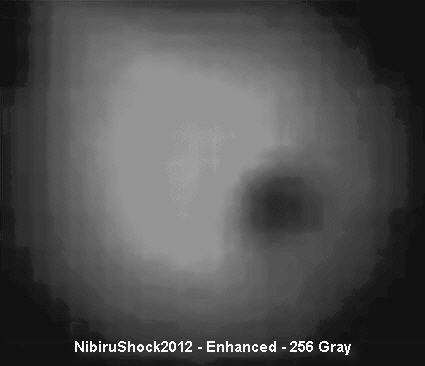 NibiruShock2012 - Enhanced - 256 Gray
NibiruShock2012 - Enhanced - 256 Gray
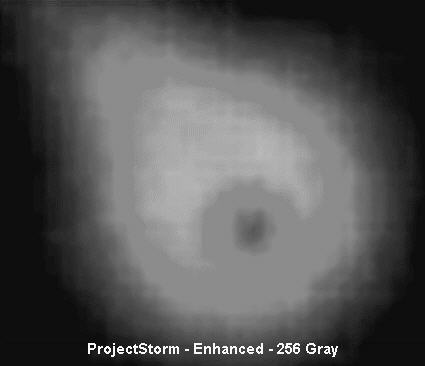 ProjectStorm - Enhanced - 256 Gray
ProjectStorm - Enhanced - 256 Gray
The dead giveaway here is the satellite passing in front of the brown dwarf (dark star).
In NibiruShock2012's image, the satellite is passing in front and to the right of the star with a natural effect. On the other hand, ProjectStorm's image resembles an amoeba more closely than anything else.
The point here is that ProjectStorm's images simply cannot stand up to close inspection, as those of NibiruShock2012 can. Conclusion
ProjectStorm was not doing valid research or a public service, either, for that matter. ProjectStorm approached his or her analysis with a highly-charged agenda. He or she fully intended to discredit and humiliate NibiruShock2012 in any way possible. In the process, his or her own hubris not only proved to be his or her downfall; it also proved the exact opposite for NibiruShock2012's video. It proved that NibiruShock2012's video is not a Photoshop hoax.
3. Renseignement humain
Janice Manning, YOWUSA.COM, 02-March-2008
The following is a Human Intelligence (HUMINT) analysis based on all of the text embedded in and associated with the Planet X / Nibiru Shock 2012 video.
The Planet X / Nibiru Shock 2012 video evidenced three separate, distinct "author's voices" to wit:
- SPT Informant
- Video Producer
- YouTube Poster
This analysis begins with an analysis of the SPT Informant, using the the four time-stamped and numerically sequenced images from the telescope camera.
The SPT Informant
The SPT Informant, presumably an American working at the Amundsen-Scott South Pole Station, captured the four images shown in the video and referenced here.
Image #1 — 01-Jan-2008
Date, Time Seq. Num.
Difference
Daily Avg
01/01/08, 06:31 AM
LOO# 51223
0
1
![]()
01/01/08, 06:31 AM
This area of space has been monitored daily since 01/01/08. This was the first recorded picture in the video, so it has a difference value of 0 and a daily average value of 1. However, observe the changes to these values as the other images are listed.
Image #2 — 10-Jan-2008
Date, Time Seq. Num.
Difference
Daily Avg
01/10/08, 14:30 PM
LOO# 51229
6
0.6
![]()
01/10/08, 14:30 PM
This was the second recorded picture. Note the sequence number. Six images were taken with that camera in the ten days between 01/01/08, 06:31 AM and 01/10/08, 14:30 PM. This produced a daily average for that period of 0.6
Image #3 — 15-Jan-2008
Date, Time Seq. Num.
Difference
Daily Avg
01/15/08 10:03 AM
LOO# 51236
7
1.4
![]()
01/15/08 10:03 AM
As of the third recorded picture, taken five days after Image #2, we see the daily average of images increasing as the time between samplings decreased. In fact, Image #3's average more than doubled over the average for Image #2.
Image #4 — 20-Jan-2008
Date, Time Seq. Num.
Difference
Daily Avg
01/20/08 21:43 PM
LOO# 51259
23
4.6
![]()
01/20/08 21:43 PM
By the time that Image #4 had been captured, that camera had captured a total between 01/01/08, 06:31 AM and 01/20/08, 21:43 PM of 37 images of that area of space. This indicates that the SPT Informant chose the images very carefully to obtain a well-rounded, representative sample of four images out of those 37.
The fact that the SPT astronomers took 23 images in the last five days of this sequence shows a dramatically increasing interest in that area of space at that time. This also shows in the fact that the daily average of images for #4 tripled that of images for #3.
The Video Producer
The Video Producer, presumably from an English-speaking country as either a natural citizen or immigrant, produced the video, adding text by using Computer-Generated Imagery (CGI).
The producer wrote it in a pseudo-American style. It had consistent typographical errors, misspelling "visible" twice and January once, with very minimal punctuation.
The producer also wrote it in what newspaper editors call Passive Voice. Here are some very simple formulas for determining Active Voice sentences from Passive Voice sentences:
* Active Voice sentence: (Person) "A" used "B" to do "C."
* Passive Voice sentence: "B" was used by (person) "A" to do "C." (OR) "C" was done with "B" by (person) "A."
Here is a representative Passive Voice paragraph from the video:
"The following pictures you are about to see are of the dark star Nibiru with its orbiting moons and Planet X. They were taken with a photographic telescope located in Amundsen-Scott American South Pole Station (SPT) in january of this year."
Both sentences in the above paragraph are in Passive Voice. Passive Voice is common for people who are not American but can write in English.
To illustrate the point, had the the first sentence in the above quotation been written in Active Voice, it would have read something like:
"You are about to see the following pictures of the dark star Nibiru with its orbiting moons and Planet X."
Regardless of the Writer's Voice and typos, the care and sense of urgency of the producer show in the last three CGI sentences:
"These objects are heading towards us and they will become visable to every human on Earth within the next couple of years. This is a matter of National Security and the governments of the world are trying their best to prevent global panic. They're also trying their best on how to deal with this unavoidable event."
The compassionate tone in this last CGI text recognizes the concern of world governments that this will cause a panic. In essence, this chain of informants does not see the governments as the "bad guys" and wants the viewer to understand that. On the other hand, a disinformation ploy would have ended on a strong conspiratorial note.
However, the message "they're trying their best" clearly shows compassion but a lack of conviction in the ability of the governments to overcome their own bureaucratic inertia and broach this information in a timely manner. This one paragraph clearly shows how this concern that bonded the members of this disclosure chain.
The YouTube Poster
The person who posted to YouTube wrote in a Continental English style used by English-speaking Europeans. The poster is not a professional writer, as this person consistently inserted commas into the wrong places. However, the tone of the posting indicated a sincere interest in the urgency of a Planet X flyby.
Here is an example of the Continental English spelling (realise) and a copy of the poster's urgent plea.
1. Spelling: What many people do not realise, is that Nibiru is infact a dark star, about half the size of our Sun. ("Infact" is a typographical error in both types of English.)
2. Plea / Challenge: Many people can be saved, but actions need to be taken NOW. If we leave it to the last minute, it will be to late. Within the next few years, nobody will be able to hide the fact these objects are heading towards us, because they will be seen by everyone and will grow larger as they approach us. Global panic is unavoidable and this event is unavoidable.
During the analysis, co-authors Jacco van der Worp, MSc and Benjamin Cropley often noticed that the level of expertise in astronomy was solid with regards to the SPT Informant and less so with the Video Producer.
They both concur that the YouTube Poster is essentially illiterate about the astronomy presented in this video and crafted the About Text using general concepts available from the Web.
Conclusion
This article demonstrates how these important images show incoming objects. It shows how the images prompted regular, everyday people, such as the producer, to make the video, and the poster, to post it to YouTube. The sense of urgency in all three people is gravely evident in all of their work.
We, as researchers, need to continue to encourage credible work, such as this, and to vet what we do receive to keep readers informed as fully as possible.
4. Orbite des satellites
Jacco van der Worp, MSc, YOWUSA.COM, 02-March-2008
L'objectif de cette analyse était de déterminer la stabilité (ou instabilité) de ce système. Nous avons réalisé cela en reconstruisant les orbites de 4 des satellites les plus brillants (voir ci-dessous) de la vidéo de NibiruShock2012 et compte tenu des données limitées disponibles.
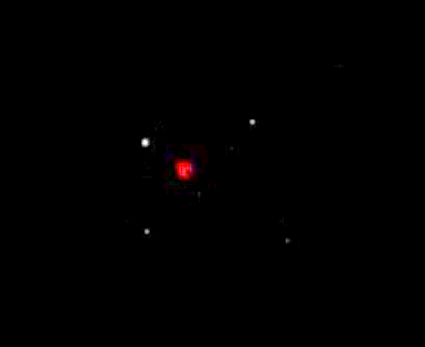 La planète X / Nibiru et ses satellites
La planète X / Nibiru et ses satellites
L'auteur a renforcé les variantes inverses de 4 images, respectivement prises le 1, 10, 15 et 20 Janvier et les a superposées les unes aux autres pour reconstruire les orbites avec l'objet central pris comme point de référence.
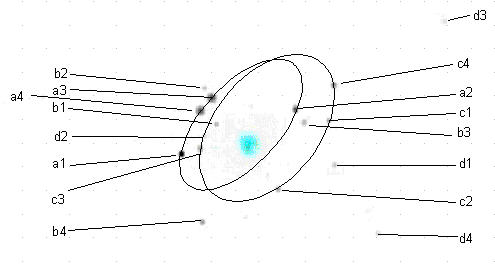 [note: ci-dessus, l'analyse photo réalisée est erronée pour plusieurs raisons, j'y reviendrais]
[note: ci-dessus, l'analyse photo réalisée est erronée pour plusieurs raisons, j'y reviendrais]
Dans cette reconstruction par couches, nous avons utilisé une hypothèse de travail qui est que les échelles des images étaient conservées à l'identique.
Objet A — Période orbitale de 22 à 25 jours
Le satellite le plus brillant, nommé a1 jusqu'à a4, suivant ces 4 positions sur l'image ci-dessus, peut être placé suivant une ellipse autour de l'objet central.
Cependant, However, looking at the dates, there is a catch. From position 1 to position 2 is nearly halfway around the ellipse, meaning that the object moves around the center of the system in approximately 20 days. This assumes, of course, that this object traveled from point 1 to 2 without completing a full orbit in between.
Between positions a3 and a4, there should then be roughly a quarter of the orbit. There isn't. This simple orbit solution, therefore, appears to be incorrect. There is, however, one possible explanation for this elliptical orbit solution that could hold for these four positions.
This possibility, be it remote, is that position a2 is 1 to 3 days past the pericenter of object a, because in that case, the orbital velocity between a1 and a2 would logically be much higher than between point a3 and a4.
Our field of view would then be at a shallow angle to the plane of this orbit. In that case, the orbit would have a period of 22 to 25 days.
Object B — Unstable Orbit
Object b cannot be fitted into an elliptical orbit at all; its orbit must therefore be an unstable orbit.
Object C — Orbital Period of 21 to 22 Days
Object c can again be fitted into an ellipse. It travels only roughly a fifth of that elliptical path between the first two dates. Its orbit seems more circular than orbit a, which would mean object c has an orbital period of 45 days, which is around 2 times that of object a.
The size of the orbit of object c does not appear much larger than the orbit solution for object a. This would mean a contradiction between the two. The answer could be similar to the answer for object a, a shallow angle of view at the orbit plane.
The angle along the path between position c3 and c4 is larger than that between position c1 and c2 for the orbit. The time between c3 and c4 is, however, only half that between c1 and c2.
The only possibility for that appears to be that position c3 is 1 to 2 days before pericenter of the orbit. Even with this pericenter position this orbit solution is probably not correct, though, given the relative distance to the center object along the path, even at this shallow angle of view. If it is correct, this object has an estimated orbital period of 21 or 22 days.
Object D — Unstable Orbit
Object d again cannot be fitted along any elliptical path around the center object. It must also have an unstable orbit.
Conclusion
The conclusion on the analysis of the orbits is that they may in fact be actual orbits of satellites around the bigger center object. Two of the four do not have stable orbits, in that case.
This could be due to instability of the center object or to the Kozai mechanism, which destabilizes an orbit if it is at a steep angle to the rest of the system.
The planes of the two orbits that seem to match elliptical solutions are at roughly a 40-60 degree angle towards each other. As a result, this entire system is not likely to be stable any more.
The effects of the Kozai mechanism are notable; two of the four objects have destabilizing orbits that will probably not exist much longer before they break away, while the other two seem to be starting to destabilize, as well. Approaching this system, therefore, is likely to be dangerous.
5. Groupe d'objets
Benjamin Cropley, yowusa.com, 2 mars 2008
La grande quantité de détails présentés dans ces captures d'écran de la vidéo YouTube indique clairement que ces images proviennent d'originaux de très haute qualité. C'est le genre de niveau qualité que l'on attendrait d'un système CCD de haute résolution dans des téléscopes modernes.
L'image suivante est une version améliorée [NdT: de quelle façon?] de l'image #4
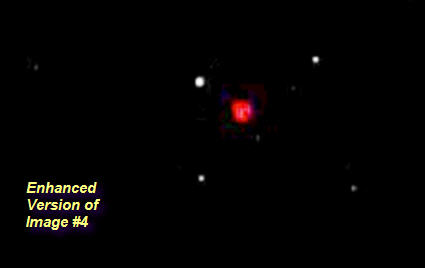 Planète X, Image #4 améliorée.
Planète X, Image #4 améliorée.
L'objet rouge au centre est une naine brune (étoile sombre) disposant de 4 gros satellites. Rappoetés à la naine brune, les satellites évoluant dans le groupe ne sont pas complètement sphériques. C'est important car généralement c'est selon l'une des 3 raisons suivantes qu'un satellite devient sphérique:
- sa taille,
- son temps passé en orbite et en rotation,
- La gravité de l'objet lui même
Après étude détaillée, ayant amélioré et agrandit les images, nous avons été capables d'obtenir des images plus nettes des objets orbitant autour de la naine brune [NdT: de quelle façon?]
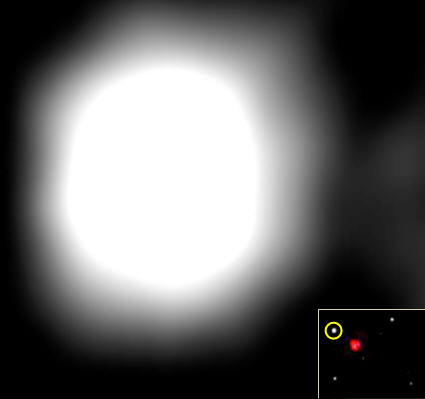 Planète X Satellite - En haut à gauche
Planète X Satellite - En haut à gauche
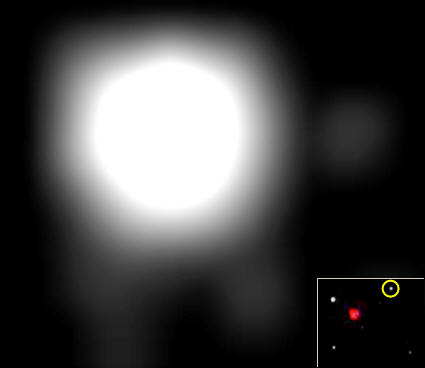 Planète X Satellite - En haut à droite
Planète X Satellite - En haut à droite
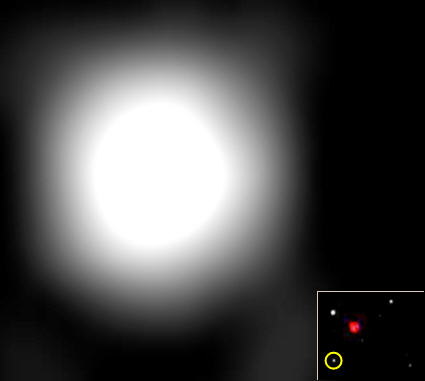 Planète X Satellite - En bas à gauche
Planète X Satellite - En bas à gauche
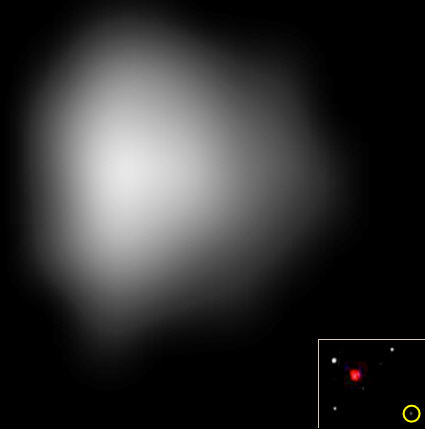 Planète X Satellite - En bas à droite
Planète X Satellite - En bas à droite
A ce point, le rédacteur fait référence au travail de Jacco van der Worp, MSc de yowusa.com et de Andy Lloyd de darkstar1.co.uk (?)
Les orbites instables des satellites
Dans son analyse, Jacco examine les trajectoires des orbites des satellites et conclut que certains d'entre eux semblent avoir des orbites instables. Ces satellites avec des orbites instables feraient éventuellement l'une des trois choses suivantes:
- Se stabiliser.
- Rentrer en collision avec la naine brune.
- Etre éjecté par l'attraction gravitationnelle causée par un autre corps.
L'imagerie indique clairement que les satellites orbitant autour de la naine brune n'ont pas été en orbite suffisamment longtemps pour devenir sphériques. Notez particulièrement le satellite situé en bas à droite, qui apparait plus triangulaire, et le satellite en haut à gauche, en forme de ballon de rugby, ce qui rappelle les lunes de Mars. De plus, alors que d'autres satellites plus anciens pourraient orbiter autour de cette naine brune, ils n'apparaissent pas sur les images disponibles.
Cela soutient totalement l'idée de Jacco, qui pourtant s'inscrit dans une analyse distincte à la mienne.
L'hypothèse d'Andy Lloyd
Un autre aspect de ces images est qu'elles offrent une corroboration de l'hypothèse d'Andy Lloyd à propos du "gap" de la ceinture de Kuiper. Théorie dans laquelle il postule que la naine brune passe au travers de la ceinture d'Edgeworth-Kuiper tel un énorme aspirateur.
A cet endroit dans la ceinture d'Edgeworth-Kuiper, il y a effectivement comme un trou. Les astronomes pensent que ce trou est la conséquence de l'influence gravitationnelle de Neptune. Comme ils l'expliquent, Neptune est capable de "capturer" un objet de la ceinture de kuiper, puis de l'éjecter dans l'orbite de saturne. De là, l'objet s'échappe du système solaire et devient un objet isolé dans l'espace profond.
Cependant, les preuves présentées par ces images ne supportent pas cette explication (?). En revanche, elles corroborent l'hypothèse d'Andy Lloyds selon laquelle la naine brune passe au travers de la ceinture de Kuiper, où son immense influence gravitationnelle capture un grand nombre d'objets.
Par conséquent, il est probable qu'une foule d'autres satellites soient associés à ce groupe, mais les satellites ne figurent pas dans les images.
Par conséquent, une foule d'autres satellites est plus probable associés à ce groupe, mais les satellites ne figurent pas dans les images. En supposant que cela soit vrai, ils varient en taille des objets de la taille d'un grain de sable pour les petits planetoids. À l'instar de ceux dans les images, ils ne sont pas encore entièrement sphérique. Supposant que cela soit vrai, leur taille varierait d'objet de la taille d'un grain de sable à un petit planétoïde. A l'instar de ceux présents sur ces images, ils ne seraient pas entièrement sphériques.
Conclusion
Ce n'est qu'en ayant amélioré ces photos que nous avons été capable de distinguer la forme de ces objets. Cette observation est incroyablement importante du point de vue du rédacteur, car il renforce deux analyses séparées sur ce groupe d'objets. Compte tenu de ces raisons, le rédacteur incline à croire que ces photos sont effectivement réelles.
